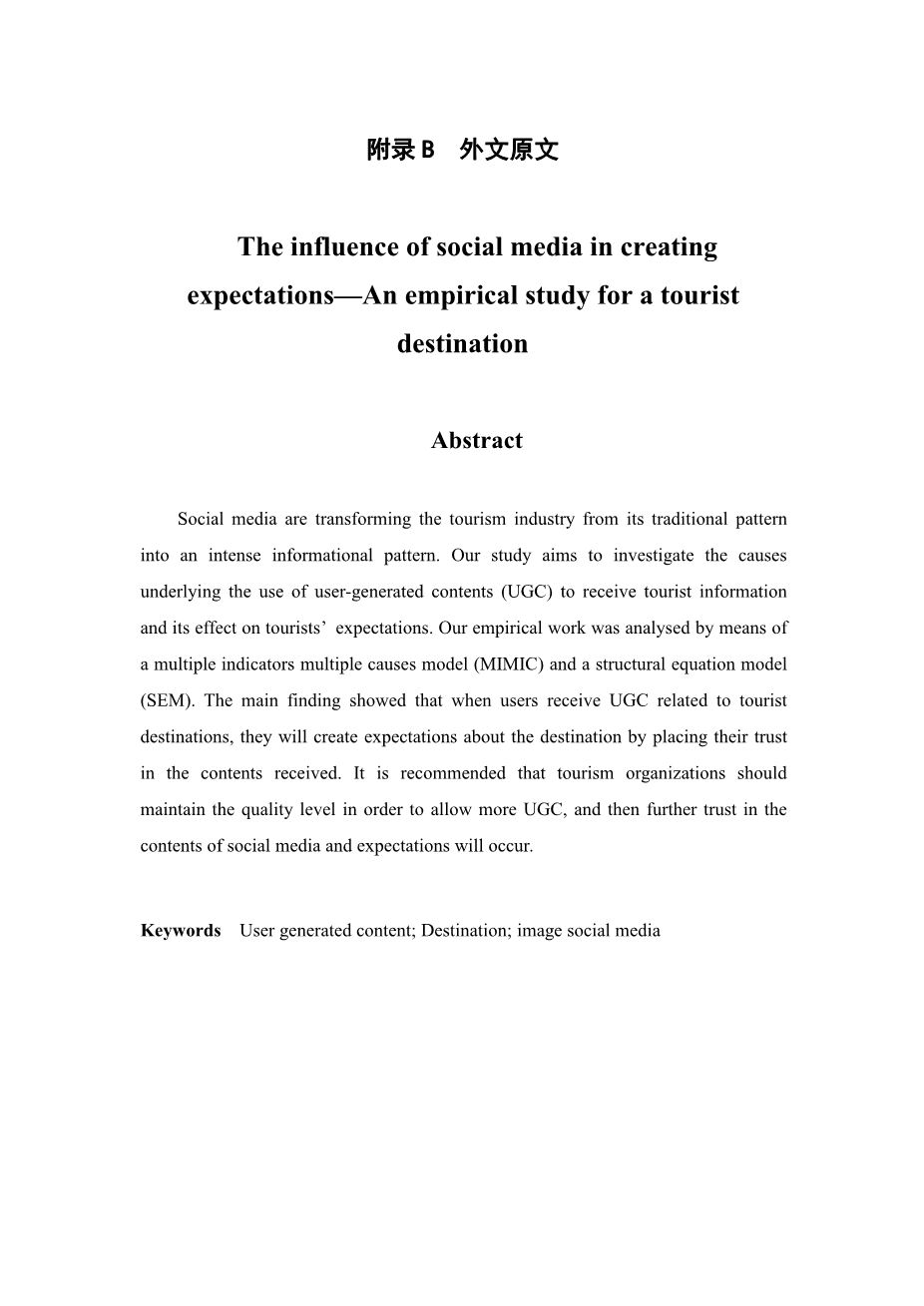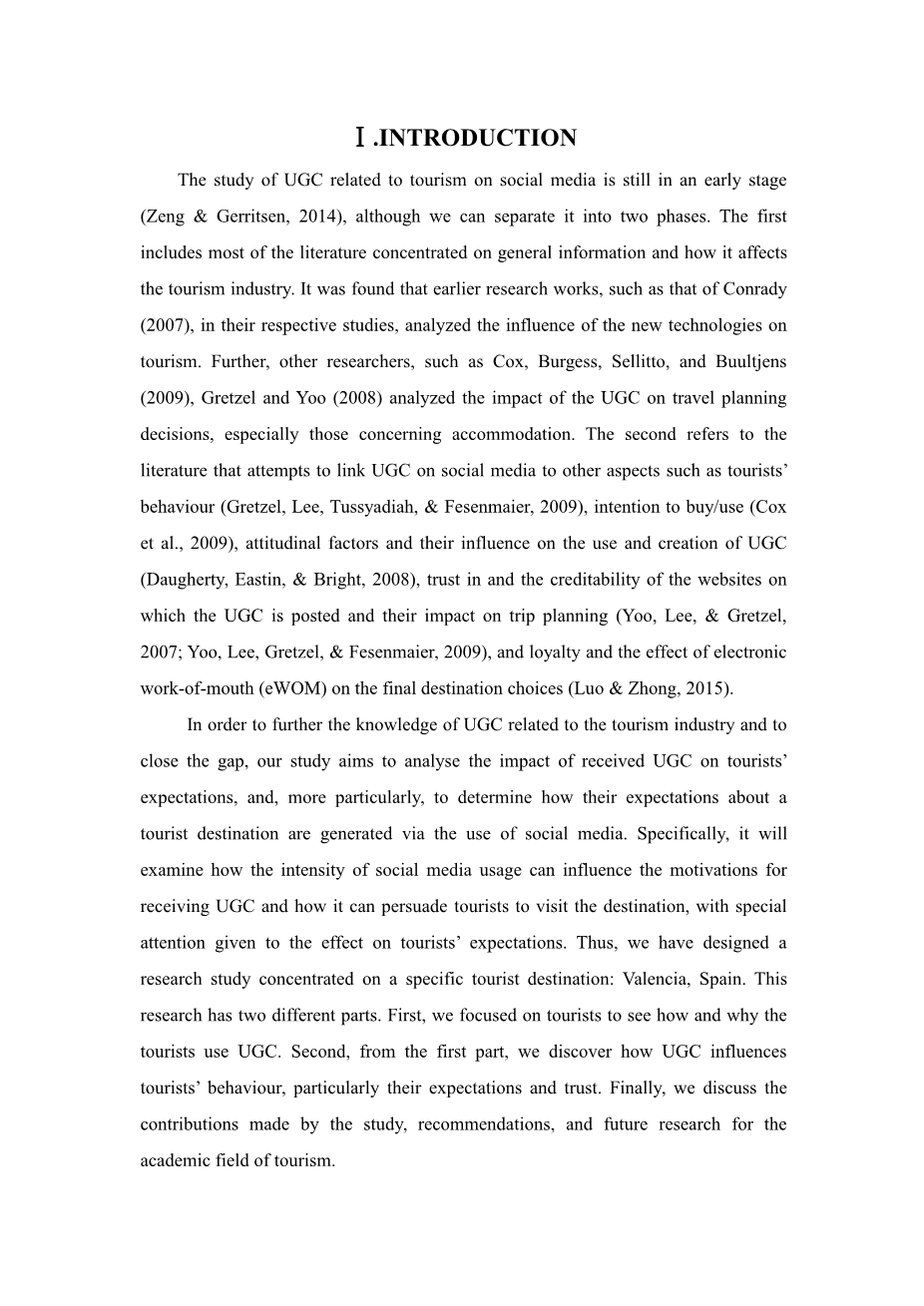Annals of Tourism Research 65 (2017) 60–70
Contents lists available at ScienceDirect
Annals of Tourism Research
journal homepage: www. elsevier.com/locate/ atoures
The influence of social media in creating expectations. An empirical study for a tourist destination
Yeamduan Narangajavana ⇑, Luis José Callarisa Fiol, Miguel Ángel Moliner Tena, Rosa María Rodríguez Artola, Javier Sánchez García
Departamento de Administración de Empresas y Marketing, Universitat Jaume I, Castellón de la Plana 12071, Spain
a r t i c l e i n f o
Article history:
Received 26 November 2015
Revised 15 January 2017
Accepted 5 May 2017
Available online 23 May 2017
Keywords:
User-generated content Trust
Expectations MIMIC model SEM model Social media
a b s t r a c t
Social media are transforming the tourism industry from its traditional pattern into an intense informational pattern. Our study aims to investigate the causes underlying the use of user-generated contents (UGC) to receive tourist information and its effect on tour- ists’ expectations. Our empirical work was analysed by means of a multiple indicators mul- tiple causes model (MIMIC) and a structural equation model (SEM). The main finding showed that when users receive UGC related to tourist destinations, they will create expec- tations about the destination by placing their trust in the contents received. It is recom- mended that tourism organizations should maintain the quality level in order to allow more UGC, and then further trust in the contents of social media and expectations will occur.
© 2017 Elsevier Ltd. All rights reserved.
Introduction
Social media have an impact on tourism, especially in the way the way travellers access and use tourism information (Xiang, Magnini, amp; Fesenmaier, 2015). These media have affected the tourism environment by changing the behaviour of both tourists and business sectors (Jacobsen amp; Munar, 2012). While social media and the Internet was becoming popular among tourists (Xiang amp; Gretzel, 2010), the tourism industry turned into an information-intense industry, since the social media allow tourists to challenge and collaborate in producing, consuming and distributing travel information through the Internet (Yoo amp; Gretzel, 2009). In addition, Xiang et al. (2015) added that the arrival of online and cloud access through mobile devices can create new sources of information to be searched, which later tend to become progressively more promi- nent in guiding travel decisions.
Due to the fact that the social media have various utilities, they have gained a substantial amount of popularity in trav- ellers’ use of the Internet (Nezakati et al., 2015; Zeng amp; Gerritsen, 2014). The reasons for this popularity are that social media allow large numbers of people to express opinions, feeling, experiences, etc. in an innovative way (Luo amp; Zhong, 2015). Sim- ilarly, in our case, these people are tourists who can search for, read and receive information regarding tourist suppliers and tourist destinations through the reviews that were posted by other tourists via social media (Chung amp; Koo, 2015; Sigala, Christou, amp; Gretzel, 2012). Hence, the reviews posted on social media, which recent literature has named user-generated
E-mail addresses: ynaranga@uji.es (Y. Narangajavana), callaris@uji.es (L.J. Callarisa Fiol), amoliner@uji.es (M.Ángel Moliner Tena), artola@uji.es (R.M. Rodríguez Artola), jsanchez@uji.es (J. Sánchez García).
http://dx.doi.org/10.1016/j.annals.2017.05.002 0160-7383/© 2017 Elsevier Ltd. All rights reserved.
content (UGC) or consumer-generated media (CGM), are important for both generating and acquiring information related to travel.
The study of UGC related to tourism on social media is still in an early stage (Zeng amp; Gerritsen, 2014), although we can separate it into two phases. The first includes most of the literature concentrated on general information and how it affects the tourism industry. It was found that earlier research works, such as that of Conrady (2007), in their respective studies, analysed the influence of the new technologies on tourism. Further, other researchers, such as Cox, Burgess, Sellitto, and Buultjens (2009), Gretzel and Yoo (2008) analysed the impact of the UGC on travel planning decisions, especially those con- cerning accommodation. The second refers to the literature that attempts to link UGC on social media to other aspects such as tourists’ behaviour (Gretzel, Lee, Tussyadiah, amp; Fesenmaier, 2009), intention to buy/use (Cox et al., 2009), attitudinal fac- tors and their influence on the use and creation of UGC (Daugherty, Eastin, amp; Bright, 2008), trust in and the creditability of the websites on which
剩余内容已隐藏,支付完成后下载完整资料


英语译文共 5 页,剩余内容已隐藏,支付完成后下载完整资料
资料编号:[434976],资料为PDF文档或Word文档,PDF文档可免费转换为Word
您可能感兴趣的文章
- COVID-19时期的旅游业和可持续发展:以西班牙为例外文翻译资料
- 农民相对剥夺感对乡村旅游可持续发展的影响机制外文翻译资料
- 校园大学生的旅行行为——以亚洲某乡村大学为例外文翻译资料
- 内容旅游与地方社区响应:鹫宫的“幸运之星”和“协作动漫旅游”外文翻译资料
- 基于符号互动理论的遗产旅游资源开发与重塑——以良渚古城遗址为例外文翻译资料
- 在TikTok上映射互联网名人:探索注意力、经济和可见性劳动力外文翻译资料
- 基于社区游客视角的环境责任行为的概念和度量外文翻译资料
- 温泉小镇的再造:维希的独特案例——副标题外文翻译资料
- 基于IP理念的桐乡丰子恺文化旅游开发研究外文翻译资料
- 特殊事件对旅游业的影响及其应对措施研究——新冠肺炎疫情对全球旅游业的影响及其应对措施外文翻译资料


